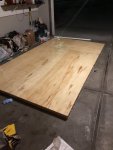walking eagle
Observer
I guess I don't understand the concern for strength.
1. As far as the base, it's all going to have a metal frame work that the foam pannels are placed into, then fiberglassed over the whole thing. Inside too as I explained earlier.
2. http://www.youtube.com/watch?v=7eUt0YnNF3o&feature=related
3. Because the moment of intertia is increased so much by having the foam in the center is is stronger than it just being fiberglass. That means it's stronger, pound for pound than a Casita, or a Wilderness flip-pac, or a normal truck topper, or a tentrax
http://www.tentrax.com/OffRoadAT_Trailer.html?gclid=CKiMj9yDh6ACFRMNDQod21UU1A
4. It's stonger, pound for pound, than skining it in metal - aluminum or steel.
So, I could take the whole frame (all the grey), and then put sheet steel on it, say, 24 guage. The sheet steel is adding very little to the structural integrety of the whole trailer. If I tied it down at three corners and put a weight at the 4th corner, the twist or deflection that could be measured at that forth corner would change very little with the sheet attached or not. Now, if you did the same thing with the foam and fiberglass, glass it up to make the weight equivalent, and that 4th corner will twist / drop much less.
Why is that important to me? I don't want to make the frame out of any heavier material than I have to. If it's all one unit construction, I can make it weigh less. I don't intend on packing 1,000 lbs of ammo into the trailer, so I don't need it built like a military trailer. Heaviest part of the whole thing will likely be the 37" Hummer tires....
Oh, and notice, the frame has metal in certain area's I would consider to be high potential of impact areas.
Now, on the finish, that would take a ship load of work from what I've seen and done, to get it paintable. Fortunately, I'm not at all above coating the whole thing with Durabak!
I'm picking up some foam tonight for a smaller project - as in smaller than a shoe box. We'll see how that goes. Figgure I'll start small, like what I did in college, and then step up to something inbetween (thinking pods on either side of drawer system in my 80), then the trailer. Then if that turns out, then maybe I'll think about a camper pod or pop-up on the top.
1. As far as the base, it's all going to have a metal frame work that the foam pannels are placed into, then fiberglassed over the whole thing. Inside too as I explained earlier.
2. http://www.youtube.com/watch?v=7eUt0YnNF3o&feature=related
3. Because the moment of intertia is increased so much by having the foam in the center is is stronger than it just being fiberglass. That means it's stronger, pound for pound than a Casita, or a Wilderness flip-pac, or a normal truck topper, or a tentrax
http://www.tentrax.com/OffRoadAT_Trailer.html?gclid=CKiMj9yDh6ACFRMNDQod21UU1A
4. It's stonger, pound for pound, than skining it in metal - aluminum or steel.
So, I could take the whole frame (all the grey), and then put sheet steel on it, say, 24 guage. The sheet steel is adding very little to the structural integrety of the whole trailer. If I tied it down at three corners and put a weight at the 4th corner, the twist or deflection that could be measured at that forth corner would change very little with the sheet attached or not. Now, if you did the same thing with the foam and fiberglass, glass it up to make the weight equivalent, and that 4th corner will twist / drop much less.
Why is that important to me? I don't want to make the frame out of any heavier material than I have to. If it's all one unit construction, I can make it weigh less. I don't intend on packing 1,000 lbs of ammo into the trailer, so I don't need it built like a military trailer. Heaviest part of the whole thing will likely be the 37" Hummer tires....
Oh, and notice, the frame has metal in certain area's I would consider to be high potential of impact areas.
Now, on the finish, that would take a ship load of work from what I've seen and done, to get it paintable. Fortunately, I'm not at all above coating the whole thing with Durabak!
I'm picking up some foam tonight for a smaller project - as in smaller than a shoe box. We'll see how that goes. Figgure I'll start small, like what I did in college, and then step up to something inbetween (thinking pods on either side of drawer system in my 80), then the trailer. Then if that turns out, then maybe I'll think about a camper pod or pop-up on the top.
Attachments
Last edited:
















